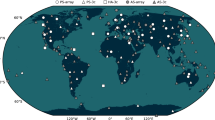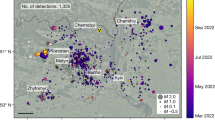Abstract
This paper reports on a joint meeting of the Royal Astronomical Society's Joint Association for Geophysics and VERTIC (the Verification Technology Information Centre) held in London in 1992. The topics presented focused on the detection and recognition of underground nuclear explosions. The objective of the meeting was to emphasize the multi-methodological approach that is important in verifying compliance with test-ban treaties. An overview of seismological monitoring was followed by a discussion of the technical and scientific aspects of a global seismic monitoring network, and in particular of the 1991 experiment to test the large-scale international exchange of seismic data between recording stations and data centres world-wide. The current capabilities of satellite remote-sensing were presented, and their use explained in terms of both the provision of information for monitoring the development of foreign nuclear testing programmes and also for providing sufficient information for the evaluation of treaty compliance. A review of radio-isotope sampling showed how the isotopic signature of both air and ground based sampling programmes can be diagnostic of the nuclear source. Finally, previously classified research on the ionospheric effects of underground nuclear explosions was presented, the generated acoustic waves disturbing the ionosphere and producing detectable changes in the reflection of radio and radar signals which have potential as a monitoring technique.
Similar content being viewed by others
References
Bjurman, B., Degeev, L., Vintersned, I., Rudjord, A.L., Ugletueit, F., Aaltonen, H., Sinkko, K., Rantavaara, A., Nielsen, S.P., Aarkrag, A. and Kolb, W.: 1990, “The detection of radioactive material from a venting underground nuclear explosion”,J. Environ. Radioactivity 11, 1–14.
Blandford, R.R.: 1977, “Discrimination between earthquakes and underground explosions”,Ann. Rev. Earth Planet. Soc. 5, 111–122.
Broad, W.J.: 1986, “Photos Said to Show New Activity at Main Soviet Nuclear Test Site”,New York Times,4, August.
Broad, W.J.: 1992, “Russia is Now Selling Spy Photos From Space”,New York Times, 4 October 1992.
BSVRP Working Group: 1989, “The British Seismic Verification Research Project”,Quarterly Jo. Roy. Astr. Soc.,30, 311–324.
Cambray, R.S., Fisher, E.M., Salmon, L. and Brooks, W.L.: 1980, “Methods of collection and analysis of radioactivity from distant nuclear test explosions”,AERE - R 5898. HMSO.
Clark, R.A. and Pearce, R.G.: 1988, “Identification of multiple underground explosions using the relative amplitude method”,Bull. Seis. Soc. Am.,78, 885–897.
Clark, R.A., Thordason, S. and Francis, D.J.: (in press), “An assessment of regional-range seismic monitoring in Eurasia - the BSVRP project in Tajikistan”, in“Verification 1995”, eds: R. Guthrie and J. Poole, Westview Press, Boulder, U.S.A.
Douglas, A., Hudson, J.A. and Kembhavi, V.K.: 1971, “The relative excitation of seismic surface and body waves by point sources”,Geophys. Jo. Roy. Astr. Soc. 23, 451–460.
Douglas, A., Marshall, P.D., Gibbs, P.G., Young, J.B. and Blamey, C.: 1973, “P-signal complexity re-examined”,Geophys. Jo. Roy. Astr. Soc. 33, 195–221.
Douglas, A., Hudson, J.A., Marshall, P.D. and Young, J.B.: 1974a, “Earthquakes that look like explosions”,Geophys. Jo. Roy. Astr. Soc. 36, 227–233.
Douglas, A., Marshall, P.D., Young, J.B. and Hudson, J.A.: 1974b, “Seismic source in East Kazakhstan”,Nature 248, 743–745.
Douglas, A.: 1981, “Seismic source identification: a review of past and present research efforts”, in “Identification of Seismic Sources - Earthquake or Underground Explosion’ E.S. Husebye and S. Mykkelvelt (Eds) D. Reidel Publishing Company, Dordrecht, 1–48.
Douglas, A. and Rivers, D.W.: 1988, “An explosion that looks like an earthquake”,Bull. Seis. Soc. Am.,78, 1011–1019.
Evernden, J.F. and Kohler, W.M.: 1979, “Further study of spectral composition of P codas of earthquakes and explosions”,Bull. Seis. Soc. Am. 69, 483–511.
Gupta, V.: 1992, “Future Chinese Nuclear Tests on the Horizon”,Trust & Verify 30, 2–3. (See also Watts, S.: 1992, “China Ran Nuclear Test Last Week”,The Independent 30th September)
Gupta, V.: 1993, “Assessment of the Chinese Nuclear Test Site near Lop Nor”,Jane's Intelligence Review 5(8, 378–381.
Gupta, V.: 1994, “A Remote Sensing and Photogrammetric Study of the Chinese Nuclear Test Site”,unpublished PhD thesis, Imperial College.
Gupta, V. and McNab, P.: 1993, “Sleuthing from home”,Bulletin of the Atomic Scientists 49, 44–47.
Heusinkveld, M.: 1982, “Analysis of shock wave arrival times for underground explosions”,J. Geophys. Res. 87, 1891–1898.
Hudson, J.A. and Douglas, A.: 1975, “On the amplitudes of seismic waves”,Geophys. Jo. Roy. Astr. Soc. 42, 1039–1044.
Israelsson, I.: 1994, “Analysis of historical seismograms - root mean square Lg magnitudes, yields, and depths of explosions in the Semipalatinsk Test Range”,Geophys. Jo. Int. 117, 591–609.
Jasani, B.: 1992, “Satellites and Arms Verification”,Jane's Intelligence Review, August.
Kelly, E.J.: 1968, “A study of two short-period discriminants”,Massachusetts Institute of Technology, Lincoln Laboratory, Technical Note 8.
Landers, T.: 1972, “Some interesting Central Asian events on theM s :m b diagram”,Geophys. Jo. Roy. astr. Soc. 31, 329–339.
Lay, T.: 1991, “The teleseismic manifestation ofpP: Problems and paradoxes” in Explosion Source Phenomenology, Edited by S.R. Taylor, H.J. Patton, P.G. Richards,AGU Geophysical Monographs 65, 109–125.
Leith, W. and Simpson, D.: 1990, “Monitoring Underground Nuclear Tests”, Commercial Observation Satellites and International Security (edited by Michael Krepon, Peter D. Zimmerman, Leonard Spector, and Mary Umberger),Macmillan Press Limited, London, pp. 115–124.
Lilwall, R.C. and Douglas, A.: 1985, “Global seismicity in terms of short period magnitudem b based on individual station magnitude-frequency distributions”,AWRE Report No. 0 23/84, HMSO, London.
Marshall, P.D. and Basham, P.W.: 1971, “Discrimination between earthquakes and underground explosions employing an improved M, scale”,Geophys. Jo. Roy. Astr. Soc. 28, 431–458.
Pearce, R.G.: 1977, “Fault plane solutions using relative amplitudes ofP & pP”,Geophys. Jo. Roy. Astr. Soc. 50, 381–394.
Pearce, R.G.: 1980, “Fault plane solutions using relative amplitudes ofP and surface reflections: further studies”,Geophys. Jo. Roy. Astr. Soc. 60, 459–487.
Playford, K., Tooley, J. and Adsley, I.: 1993, “Radioactive fallout in air and rain: results to the end of 1991”,AEAEE-0498, HMSO.
Pomeroy, P.W., Best, W.J. and McEvilly, T.V.: 1982, “Test ban treaty verification with regional data- a review”,Bull. Seis. Soc. Am. 72, S89–S129.
Skorve, J. and Skogan, J.K.: 1992, “The NUPI Satellite Study of the Northern Underground Nuclear Test Area on Novaya Zemlya”,164, 1–51.
Stevens, J.L. and Day, S.M.: 1985, “The physical basis ofm b :M s and variable frequency magnitude methods of earthquake/explosion discrimination”,J. Geophys. Res. 90, 3009–3020.
Taylor, S.R., Sherman, N.W. and Denny, M.D.: 1988, “Spectral discrimination between NTS explosions and western United States earthquakes at regional distances”,Bull. Seis. Soc. Am 78, 1563–1579.
Thirlaway, H.I.S.: 1966, “Interpreting array records: explosion and earthquake P-wave trains which have traversed the deep mantle”,Proc. Roy. Soc. A. 290, 385–395.
Thurber, C.H., Quin, H.R. and Richards, P.G.: 1993a, “Accurate Locations of Nuclear Explosions in Balapan, Kazakhstan, 1987 to 1989”,Geophysical Research Letters 20(5, 399–402.
Thurber, C.H., Quin, H.R. and Saleh, R.: (in press), “Catalog of Locations of Nuclear Explosions at Balapan, Kazakhstan, 1965 to 1985”,Bull. Seis. Soc. Am.
Van der Vink, G.: 1994, “The Joint Seismic Program”,in 1994 Annual Report of the IRIS Consortium (Incorporated Research Institutions for Seismology), Arlington, Virginia, U.S.A.
Zimmerman, P.D.: 1993, “Study of the Nevada Test Site using Landsat Satellite Imagery”,CSIS Report, 1–9.
Zimmerman, P.D.: Del Grande, N.K. and McKinnis, W.: 1991, “Persistent Changes in the Nevada Desert Resulting from Atmospheric Nuclear Tests”,CSIS Report, 1–14.
Author information
Authors and Affiliations
Rights and permissions
About this article
Cite this article
Argo, P., Clark, R.A., Douglas, A. et al. The detection and recognition of underground nuclear explosions. Surv Geophys 16, 495–532 (1995). https://doi.org/10.1007/BF00665683
Accepted:
Issue Date:
DOI: https://doi.org/10.1007/BF00665683




